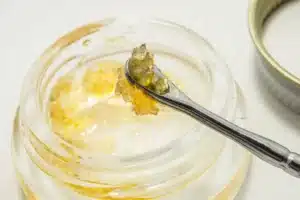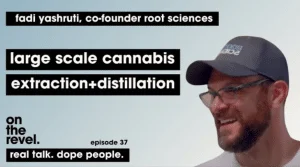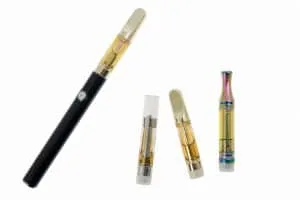As of 2024, cannabis is legal for recreational use in 24 states in the country. These relaxed laws have made it possible for some cannabis producers and processors to get even more creative with the products they make available to the public.
Cannabis extracts have always been popular, but a more intense, refined product has slowly taken center stage: cannabis distillates. Cannabis distillates are potent, pure, and flexible in how they can be used. Let’s take a closer look at these cannabis products and how they are made.
Sections
ToggleWhat Is Cannabis Distillate Made Of?
Cannabis distillate, simply put, is a super-concentrated extract created through the process of molecular distillation with cannabis distillation equipment. Cannabis distillates contain high levels of cannabinoids.
For example, THC distillate is often referred to as the most potent cannabis concentrate available, sometimes boasting as much as 99 percent pure tetrahydrocannabinol (THC).
During the distillation process, a combination of heat and pressure separates the valuable cannabinoids from the other compounds found in the extract derived from the plant.
Cannabis Distillate vs Other Cannabis Concentrates
Most other cannabis concentrates are not as purely refined as cannabis distillates.
For example, if you have a live resin, you have a product that is potent, but it will also contain a lot of other plant compounds, specifically terpenes. This is because the live resin is created via methods that protect the terpenes found in the cannabis flower.
Both products have their value. Some people prefer concentrates that contain terpenes, while others are looking for concentrates more for their high cannabinoid content. During the cannabis distillation process, most of the flavor and aroma from terpenes are removed.
However, terpenes can be added back to cannabis products. For example, terpenes can be added to cannabis products like vape cartridges for enhanced flavor and desired effects.
Understanding the Distillation Process
Cannabis distillation is a complex process that relies on the principles of fractional distillation. It is a concept that uses the varying boiling points of the various compounds to separate them. Predominantly fractional distillation is used to extract products from crude petroleum, but the same process is used in the cannabis industry to isolate specific cannabinoids, primarily THC and CBD.
Key Concepts
There are three main principles used to distill cannabis:
1. Fractional Distillation: It is a technique used to separate components in a chemical mixture into different parts (fractions) based on their boiling points. In cannabis distillation, it allows for the isolation of specific cannabinoids. Fractional distillation uses custom-made equipment to extract compounds from the cannabis plants. We will explore the apparatus used later in the article.
2. Boiling Points: The separation of compounds depends entirely on the differences in their boiling points. In the cannabis distillation process, mainly three cannabinoids are extracted:
- THC, which boils at approximately 157°C (315°F)
- CBD boiling at approximately 160-180°C (320-356°F)
- CBN which has a boiling point of approximately 185°C (365°F)
3. Separation of Cannabinoids: By precise and careful control of temperature and pressure, distillation equipment can separate and collect different cannabinoids, resulting in highly pure extracts.
Preparation Before Distillation
To ensure that the cannabis distillates are pure and potent, there is some preparation needed before the distillation process begins. This involves two main steps: sourcing and preparing raw materials and initial extraction.
Sourcing and Preparing Raw Materials
You cannot expect to extract high-quality cannabis distillate if the raw material used is not of superior quality. Starting with cannabis plants with high terpene percentage and cannabinoid content is essential. Another factor is the absence of contaminants.
The next step is to prepare cannabis for the initial extraction process. To ensure that the terpene and cannabinoid profile is strong, it is necessary to harvest cannabis at peak maturity. The next step is to dry the cannabis to minimize the moisture content to prevent mold and bacterial growth. It is followed by the curing process that further reduces moisture. Curing is necessary because it forces the plants to use sugars and starches present before these ingredients dry out and get stuck in the cannabinoids. It is necessary to enhance flavor and potency.
The last step involves trimming any excess plant material from dried content and testing for potency and potential contaminants.
Initial Extraction Methods
Before cannabis distillation, cannabinoids must be extracted from the plant material. As distillation uses the boiling point to separate components, it cannot work with the plant content present; instead, it requires cannabis oil.
Cannabis oil can be extracted using one of the following methods:
- CO2 Extraction: A simple process that uses supercritical CO2 to pull cannabinoids from the plant material. CO2 at supercritical temperature and pressure acts as both liquid and gas, producing clean extracts.
- Ethanol Extraction: This extraction process uses food-grade ethanol as a solvent for dissolving the cannabinoids from the plant extracts. The process is efficient and can be scaled easily. However, it may co-extract unwanted compounds, requiring intensive post-processing.
- Hydrocarbon Extraction: Hydrocarbons like butane or propane are used as solvents in this process. The process requires more care and expensive equipment as hydrocarbons have high flammability.
The crude oil extracted using one of the above extraction processes is then prepared for distillation. It involves four basic steps:
- Winterization: Ethanol is used to dissolve fats, lipids, and waxes in the cannabinoid oil, and then the mixture is frozen for separation.
- Filtration: Simple filters are used to remove particulates and other impurities.
- Decarboxylation: Heating the extract to convert THCA and CBDA into their active forms (THC and CBD)
- Solvent Removal: If solvents are used for extraction, evaporation is used to remove any remaining solvents.
After these steps, we move on to produce high-quality distillates.
Find the Ideal Cannabis Distillation Equipment for Your Business
How to Make Cannabis Distillate in Five Simple Steps
Making cannabis distillate is perhaps one of the most in-depth processes pertaining to making concentrates. Here is a quick look at some of the steps involved in the full process.
1. Initial Extraction
The initial extraction process involves separating the valuable, cannabinoid-rich trichome from the cannabis plant. Trichomes are sticky glands made of resin that can be found growing on the flowers of a cannabis plant.
Flavonoids, terpenes, and cannabinoid concentrations are most abundant in the trichomes. To separate the trichome from the plant, the plant matter is put through an initial extraction process using one of a few different methods, such as supercritical CO2 extraction, light hydrocarbon, or ethanol based extraction.
2. Filtration Through Winterization
The end result, after using a solvent or supercritical extraction to remove trichomes, is a valuable, but not particularly pure, crude oil. This concentrate still contains certain impurities, such as plant lipids and chlorophyll, and an array of cannabinoids and terpenes found in the trichomes.
During the winterization process, ethanol is mixed with the extracted crude oil, and then stored below freezing for up to 48 hours. This causes some of the unwanted constituents, such as plant lipids and waxes, to coagulate or harden. These unwanted compounds are then easily filtered from the chilled mixture.
3. Decarboxylation
Decarboxylation is the process of transforming cannabinoids with heat and time to enhance their ability to interact with the body’s receptors. Decarboxylation transforms the acidic forms of cannabinoids into the actual cannabinoids themselves without the acidic molecules.
For example, THCA (tetrahydrocannabinolic acid) must be converted into THC and CBDA (cannabidiolic acid) must be converted into CBD. Without this important step, the cannabinoids will not produce psychoactive effects.
Each cannabinoid becomes decarboxylated at a different temperature. The winterized, filtered crude oil is decarboxylated at the appropriate temperature to convert the desired cannabinoids.
4. Final Distillation
Final distillation involves using cannabis distillation equipment to almost completely separate the existing cannabinoids from everything else that remains in the crude oil. The distillation equipment uses precise temperature control and vacuum pressure to vaporize the different compounds.
Those vapors are then condensed onto an internally located condensing column, and the temperature difference of the column converts the vapors back into a liquid form. Because each compound remaining in the crude oil has a different boiling point, and the distiller controls temperature and vacuum pressure, specific elements and cannabinoids can be pulled out. This is why the end product can be so pure and potent.
5. Isolation
CBD distillate is a highly concentrated form of cannabidiol (CBD) extracted from the cannabis plant. It undergoes a multi-step extraction and purification process like chromatography to remove impurities and other cannabinoids, resulting in a predominantly CBD product.
THC distillate is a concentrated form of delta-9-tetrahydrocannabinol (THC), the psychoactive compound found in cannabis. Additional purification steps may be taken to ensure the distillate primarily contains THC, depending on the desired purity level. Chromatography or other techniques may be used for further isolation if needed.
Equipment Needed for Cannabis Distillation
The distillation process requires micro control over the temperature and process to maintain appropriate boiling temperatures.
Essential Distillation Equipment
Short path distillation setup is a compact system that minimizes the distance vapor travels from the evaporation flask to the condenser. In the laboratory, such a setup consists of glassware, but for commercial cannabis distillation, you need equipment like Root Sciences’ distillation equipment. Their equipment models have varying capacities of up to 2200 pounds per shift and have stainless steel evaporator material.
Typically, any short path distillation setup will have the following:
- Boiling flask: To hold the cannabis extract
- Heated mantle: Provides controlled heat to the boiling flask
- Distillation head: It is a glass tube that connects the boiling flask to the condenser
- Condenser: It is a two-way flow equipment that cools and condenses the vapor
- Receiving flasks: It collects the condensed and distilled fractions
- Vacuum gauge and controller: To monitor and adjust system pressure
However, the industrial distillation equipment has additional components that include:
- Rotary Evaporator: Also known as a Rotovap, it is used for solvent removal and initial concentration of extracts. It has a rotating flask, heated bath, condenser, and collection flask.
- Vacuum Pump: It creates the low-pressure environment necessary for distillation. Root Sciences cannabis distillation equipment has vacuum pumps that are chemical-resistant and capable of deep vacuum (< 1 torr).
- Chillers: Simply put, they are large-scale condensers that supply cold fluid to condensers for efficient vapor condensation.
Safety Considerations
The distillation process involves handling equipment that operates under high temperatures and pressures. It is essential to have safety protocols in place. It includes:
- Regular maintenance and inspection of all distillation equipment
- Use of appropriate personal protective equipment (PPE) including lab coats, gloves, and safety goggles when handling equipment
- Training all operators on equipment use and emergency procedures
- Ensure proper ventilation in the workspace.
- Have fire safety equipment readily available
Tips for Enhancing the Quality of Distillate
There are some best practices involved in producing high-quality cannabis distillate. It requires attention to detail and specific techniques:
Achieving Higher Purity:
- Multiple distillation passes: To enhance the purity, performing multiple distillation passes is useful as it removes more impurities with each pass.
- Temperature Control: Precise temperature control during distillation ensures that only the required cannabinoids are separated without any other contaminants.
- Vacuum Control: Maintaining a stable, deep vacuum reduces the boiling point of cannabinoids, allowing for more efficient separation.
- Wiped Film Distillation: This technique can achieve higher purity by creating a thin film of extract, allowing for more precise fractional distillation.
- Proper Fractionation: It involves collecting distillate in multiple fractions and selecting the purest for the final product.
Flavor and Terpene Reintroduction
Another way to enhance the cannabis distillate quality is to reintroduce flavor and terpene into the distillate. In this process, the terpenes are isolated using low-temperature extraction and stored in a cool, dark place to preserve their integrity.
After the cannabis distillation, the terpenes are added back into the distillate. You can experiment with different ratios of terpenes to distillate to achieve desired flavor profiles. However, the terpenes must be reintroduced at lower temperatures to prevent degradation.
Common Challenges and Troubleshooting
Even with the best preparation, challenges can arise during the cannabis distillation process. The most common challenges faced by aspiring distillate producers include:
- Equipment Malfunctions: Mostly involve vacuum leaks due to worn-out seals and connections. Also, heating inconsistencies are common due to incorrectly calibrated heating mantles and controllers.
- Yield Issues: Poor pressure or temperature leads to less efficient extraction, but inconsistent yields can result from starting material or process parameter variations.
- Residual Solvents: If the staff is not trained to implement proper post-processing techniques, the extracts can have residual solvents.
Conclusion
Cannabis distillation is the process of creating high-quality cannabis distillate that requires precision, attention to detail, and a deep understanding of the principles involved. Aspiring distillate producers can easily find success by using the right equipment, following safety protocols, and implementing best practices.
Root Sciences provides a selection of cannabis distillation equipment for those seeking high-quality equipment that facilitates new technologies and techniques. As an equipment manufacturer, we stay at the forefront of distillation technology and provide comprehensive support to our clients.




